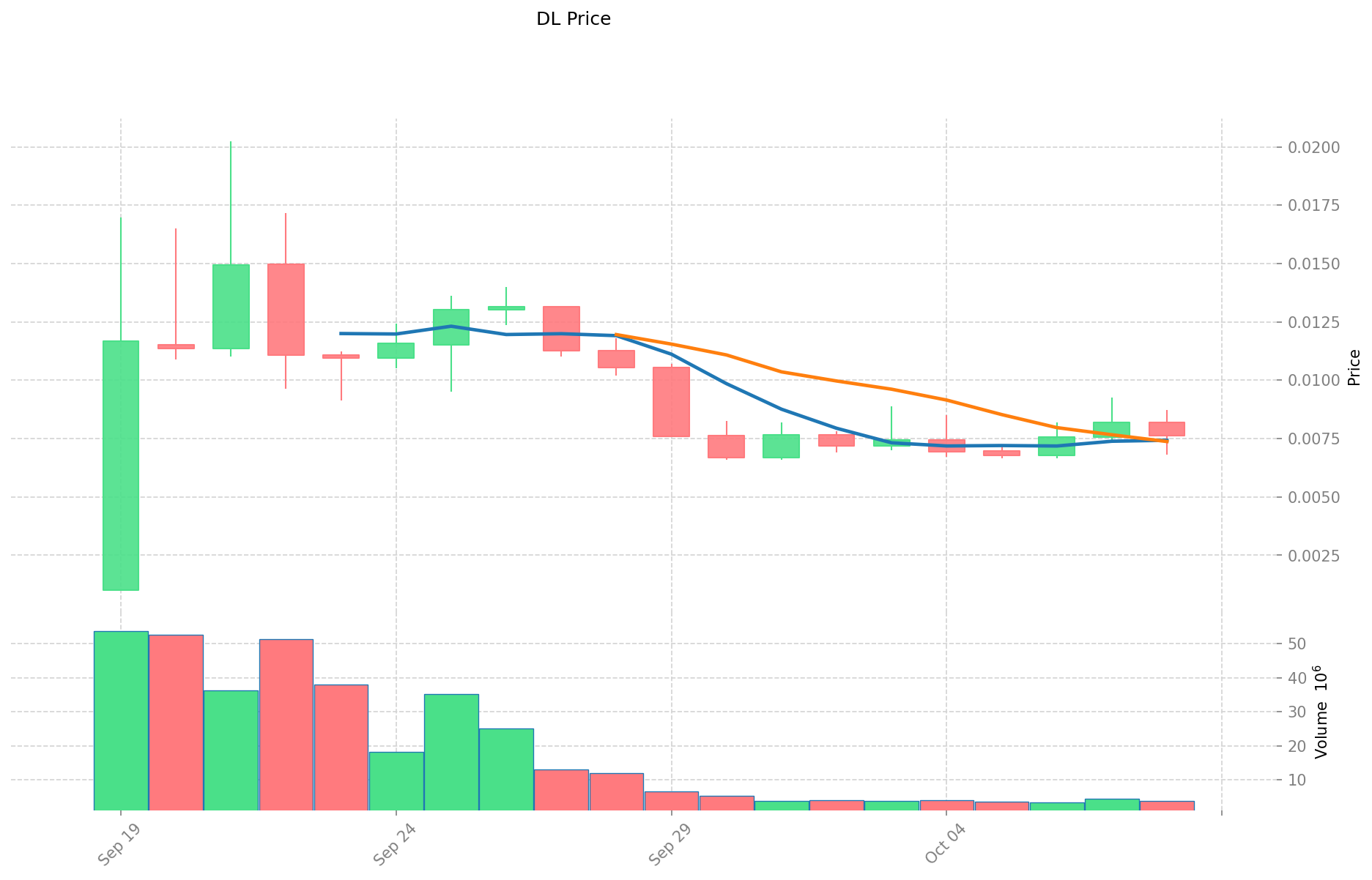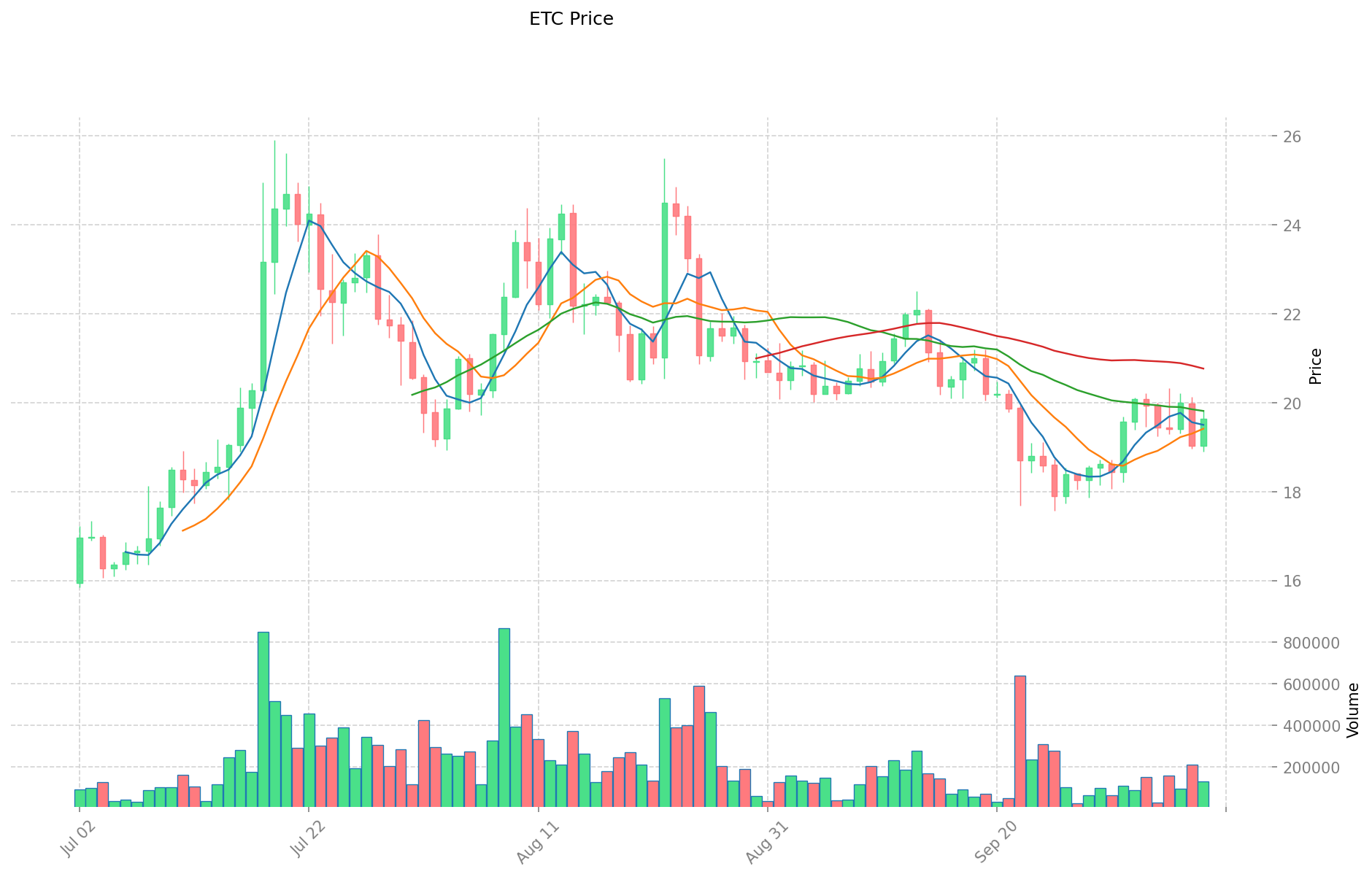DL vs ETC: Comparing Deep Learning and Exchange-Traded Commodities for Modern Investment Strategies
Introduction: DL vs ETC Investment Comparison
In the cryptocurrency market, the comparison between Dill (DL) and Ethereum Classic (ETC) has been an unavoidable topic for investors. The two not only show significant differences in market cap ranking, application scenarios, and price performance, but also represent different positions in the crypto asset landscape.
Dill (DL): Launched recently, it has gained market recognition for its focus on maximum decentralization and infinite scalability.
Ethereum Classic (ETC): Since its inception in 2016, it has been hailed as a platform for executing smart contracts, representing a continuation of the original Ethereum chain.
This article will provide a comprehensive analysis of the investment value comparison between DL and ETC, focusing on historical price trends, supply mechanisms, institutional adoption, technological ecosystems, and future predictions, attempting to answer the question investors care about most:
"Which is the better buy right now?"
I. Price History Comparison and Current Market Status
DL and ETC Historical Price Trends
- 2025: DL was launched and experienced significant price volatility in its initial trading period.
- 2021: ETC reached its all-time high of $167.09 on May 6, 2021, due to overall crypto market bullishness.
- Comparative analysis: In recent market cycles, DL has seen a price range from $0.001 to $0.02025, while ETC has ranged from $12.72 to $39.87 over the past 52 weeks.
Current Market Situation (2025-10-09)
- DL current price: $0.007628
- ETC current price: $19.63
- 24-hour trading volume: $29,177.05 (DL) vs $2,535,854.17 (ETC)
- Market Sentiment Index (Fear & Greed Index): 60 (Greed)
Click to view real-time prices:
- View DL current price Market Price
- View ETC current price Market Price


Core Value Factors Influencing DL vs ETC Investment
Supply Mechanism Comparison (Tokenomics)
- DL: Limited data available on supply mechanism
- ETC: Offers discount benefits with 95% fee reduction
- 📌 Historical Pattern: Market demand for electric vehicles creating space for smart driving software subscriptions
Institutional Adoption and Market Applications
- Institutional Holdings: Insufficient data on institutional preference
- Enterprise Adoption: Software subscription models showing promising revenue potential with full lifecycle continuous charging
- Regulatory Attitudes: Chinese regulatory authorities explicitly state they do not make substantive judgments or guarantees regarding investment value and market prospects
Technology Development and Ecosystem Building
- DL Technology Upgrades: Insufficient specific data on development roadmap
- ETC Technology Development: Integration with electric vehicle ecosystem creating new revenue opportunities
- Ecosystem Comparison: Software marginal costs are low, with profitability increasing as adoption rates rise
Macroeconomic Factors and Market Cycles
- Performance in Inflationary Environments: Insufficient comparative data
- Monetary Policy Impact: Investors must independently assess investment decisions and bear risks from operational changes and price fluctuations
- Geopolitical Factors: Declining electric vehicle usage costs creating space for smart driving software subscriptions
III. 2025-2030 Price Prediction: DL vs ETC
Short-term Prediction (2025)
- DL: Conservative $0.005784 - $0.007712 | Optimistic $0.007712 - $0.0084832
- ETC: Conservative $14.14944 - $19.652 | Optimistic $19.652 - $26.13716
Mid-term Prediction (2027)
- DL may enter a growth phase, with an estimated price range of $0.00658901712 - $0.01109290224
- ETC may enter a bullish market, with an estimated price range of $26.53481822 - $38.824628764
- Key drivers: Institutional capital inflow, ETF, ecosystem development
Long-term Prediction (2030)
- DL: Base scenario $0.013851420321438 - $0.015236562353581 | Optimistic scenario $0.015236562353581
- ETC: Base scenario $19.571712456642521 - $36.9277593521557 | Optimistic scenario $40.989812880892827
Disclaimer
DL:
| 年份 | 预测最高价 | 预测平均价格 | 预测最低价 | 涨跌幅 |
|---|---|---|---|---|
| 2025 | 0.0084832 | 0.007712 | 0.005784 | 1 |
| 2026 | 0.008583456 | 0.0080976 | 0.007206864 | 6 |
| 2027 | 0.01109290224 | 0.008340528 | 0.00658901712 | 9 |
| 2028 | 0.0144779055288 | 0.00971671512 | 0.0061215305256 | 27 |
| 2029 | 0.015605530318476 | 0.0120973103244 | 0.00665352067842 | 58 |
| 2030 | 0.015236562353581 | 0.013851420321438 | 0.012881820898937 | 81 |
ETC:
| 年份 | 预测最高价 | 预测平均价格 | 预测最低价 | 涨跌幅 |
|---|---|---|---|---|
| 2025 | 26.13716 | 19.652 | 14.14944 | 0 |
| 2026 | 32.9681952 | 22.89458 | 16.2551518 | 16 |
| 2027 | 38.824628764 | 27.9313876 | 26.53481822 | 42 |
| 2028 | 39.38604965476 | 33.378008182 | 30.37398744562 | 70 |
| 2029 | 37.4734897859314 | 36.38202891838 | 33.8352868940934 | 85 |
| 2030 | 40.989812880892827 | 36.9277593521557 | 19.571712456642521 | 88 |
IV. Investment Strategy Comparison: DL vs ETC
Long-term vs Short-term Investment Strategies
- DL: Suitable for investors focused on decentralization and scalability potential
- ETC: Suitable for investors seeking established smart contract platforms
Risk Management and Asset Allocation
- Conservative investors: DL: 10% vs ETC: 90%
- Aggressive investors: DL: 30% vs ETC: 70%
- Hedging tools: Stablecoin allocation, options, cross-currency portfolios
V. Potential Risk Comparison
Market Risks
- DL: High volatility due to recent launch and limited market data
- ETC: Susceptible to overall crypto market trends and Ethereum ecosystem developments
Technical Risks
- DL: Scalability, network stability
- ETC: Hash rate concentration, security vulnerabilities
Regulatory Risks
- Global regulatory policies may have differing impacts on both assets
VI. Conclusion: Which Is the Better Buy?
📌 Investment Value Summary:
- DL advantages: Focus on maximum decentralization and infinite scalability
- ETC advantages: Established platform for executing smart contracts, continuation of original Ethereum chain
✅ Investment Advice:
- Novice investors: Consider allocating a small portion to both, with emphasis on ETC for its established history
- Experienced investors: Balanced approach, potentially higher allocation to DL for growth potential
- Institutional investors: Conduct thorough due diligence on both assets, considering risk tolerance and investment goals
⚠️ Risk Warning: The cryptocurrency market is highly volatile. This article does not constitute investment advice. None
VII. FAQ
Q1: What are the main differences between DL and ETC? A: DL focuses on maximum decentralization and infinite scalability, while ETC is an established platform for executing smart contracts and represents a continuation of the original Ethereum chain.
Q2: Which cryptocurrency has shown better price performance recently? A: Based on the provided data, ETC has shown a wider price range ($12.72 to $39.87 over the past 52 weeks) compared to DL ($0.001 to $0.02025). However, it's important to note that DL is a newer asset with limited historical data.
Q3: How do the current market situations of DL and ETC compare? A: As of 2025-10-09, DL's price is $0.007628 with a 24-hour trading volume of $29,177.05, while ETC's price is $19.63 with a 24-hour trading volume of $2,535,854.17. ETC shows significantly higher trading volume.
Q4: What are the long-term price predictions for DL and ETC by 2030? A: For DL, the base scenario predicts a range of $0.013851420321438 - $0.015236562353581. For ETC, the base scenario predicts a range of $19.571712456642521 - $36.9277593521557.
Q5: How should investors allocate their portfolio between DL and ETC? A: Conservative investors might consider allocating 10% to DL and 90% to ETC, while aggressive investors might allocate 30% to DL and 70% to ETC. However, individual allocations should be based on personal risk tolerance and investment goals.
Q6: What are the main risks associated with investing in DL and ETC? A: Both face market risks related to crypto volatility. DL has technical risks related to scalability and network stability, while ETC faces risks of hash rate concentration and security vulnerabilities. Both are also subject to regulatory risks depending on global policies.
Q7: Which cryptocurrency might be better for novice investors? A: Novice investors might consider allocating a small portion to both, with a higher emphasis on ETC due to its more established history and ecosystem. However, all investment decisions should be made based on thorough research and individual risk tolerance.
Share
Content